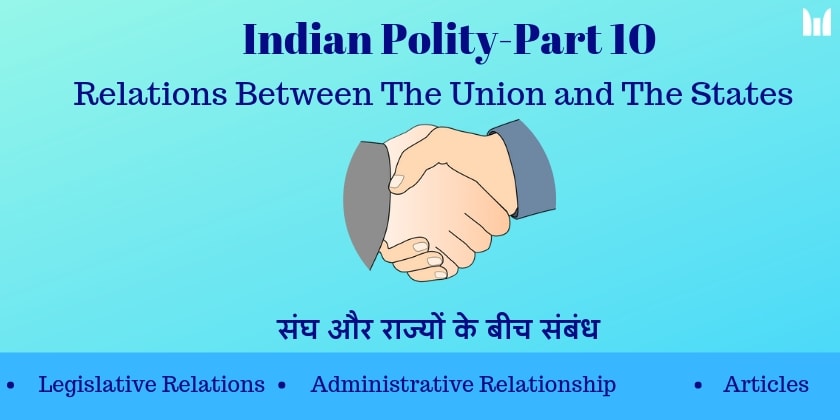Indian Constitution Part 11: Relations Between The Union and The States
The detailed discussion of the central and state relations, according to the central system in the constitution of India, has been made more powerful for the Indian unity and integrity. The relationship between centre and state is done in three perspectives.
1. Legislative Relations Article(245-255)
2. Administrative Relationship Article(256-263)
1. Legislative relations:
Article 245 to 255 in Part 11 of the Indian Constitution and 7th Schedule, the legislative relations between the Center and the State have been mentioned. Under the 7th schedule, the three-tier system has been arranged for legislative relations between the Center and the state.
i- Union list(संघ सूची)
ii- State list(राज्य सूची)
iii- Concurrent list(समवर्ती सूची)
Union List(संघ सूची)- It covers 100 subjects (essentially 97) of national and international significance on which only the parliament has the right to legislate. Such as defence, banking, currency, atomic energy, army, harbour etc.
State list(राज्य सूची)- This includes 61 subjects (basically 66) of regional and local importance, the state Legislature has the right to formulate legislation on these subjects in general conditions. Such as agriculture, public order, police, prison, health etc.
Concurrent list(समवर्ती सूची)- This list consists of 52 subjects (basically 47) of regional and national importance, on which both the Center and the State have the right to make laws. Such as education, forest, electricity, medicine, newspaper etc.
Five issues were added to the concurrent list from State List by 42th Constitutional Amendment 1976.
- Education
- Forest
- Measurement
- Protection of wild animals and birds
- Constitution of all except Supreme and High Courts
Control by the state legislature:
1. The Governor may send some bills to the President’s acceptance and the President has the power of veto on those bills.
2. Certain Bills related to the State List can be brought to Parliament only with the prior consent of the President.
3. At the time of financial emergency, the President can keep the money bill passed by the Legislature.
Articles Under Legislative Relations:
1. Article 245: Extent of laws made by Parliament and by the Legislatures of States.
2. Article 246: Subject-matter of laws made by Parliament and by the Legislatures of States.
3. Article 247: Power of Parliament to provide for the establishment of certain additional courts.
4. Article 248: Residuary powers of legislation.
5. Article 249: Power of Parliament to legislate with respect to a matter in the State List in the national interest.
6. Article 250: Power of Parliament with respect to any matter in the State List if a Proclamation of Emergency is in operation.
7. Article 251: Inconsistency between laws made by Parliament under articles 249 and 250 and laws made by the Legislatures of States.
8. Article 252: Power of Parliament to legislate for two or more States by consent and adoption of such legislation by any other State.
9. Article 253: Legislation for giving effect to international agreements.
10. Article 254: Inconsistency between laws made by Parliament and laws made by the Legislatures of States.
11. Article 255: Requirements as to recommendations and previous sanctions to be regarded as matters of procedure only.
2. Administrative Relationship:
The administrative relationship between centre and state has been mentioned in Part 11 of the Indian Constitution -Article(256 to 263) – In the federal system of government, generally the administrative relationship between the Union and the States is usually dispute, therefore, by the Constitution Such provisions have been made so that the relations between the centre and the states remain intact.
Division of executive power:
Executive and legislative powers have been split apart from the centre and the state in some areas, thus the powers of the Center are elaborated throughout India –
i. In the context of the subjects (union list) in which Parliament has legislative powers.
ii. Functional authority and jurisdiction under a treaty or agreement.
iii. The executive powers of the state are detailed on the subjects of the state to the extent of the state.
iv. The centre and state both have powers on the subject of concurrent list, but the method created by the Center in the event of a dispute will be supreme.
Cooperation between the centre and states:
Under article 258, some administrative functions can be handed over to the states by the Center and some administrative functions can be handed over to the Center by the states. According to article 261, all the parts of the Indian Territory will be given full recognition to the records and public prosecutions of the Union and State Public Works. According to article 262, Parliament has the right to make laws to decide the disputes related to the water of rivers between two or more states.
Articles Under administrative Relationship:
1. Article 256: Obligation of States and the Union.
2. Article 257: Control of the Union over States in certain cases.
3. Article 258: Power of the Union to confer powers, etc.
4. Article 258A: Power of the States to entrust functions to the Union
5. Article 260: Jurisdiction of the Union in relation to territories outside India.
6. Article 261: Public acts, records and judicial proceedings.
7. Article 262: disputes relating to Waters.
Disputes relating to Waters
Read more About disputes relating to Waters between the states under article 262.
Co-ordination between States
Read more About Inter-State Council or Co-ordination between states under the article 263.

